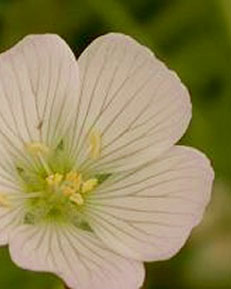
Photo © Steven Foster
Introduction
Meadowfoam is a winter-growing annual herb which reaches 10-18 inches in height, and is characterized by numerous creamy-white flowers that en masse resemble a field of white foam.1 Also known as marshflower, meadowfoam thrives in the poorly drained soils of northern California, southern Oregon, and Vancouver Island, British Columbia. The seed contains a unique oil with a longer fatty acid chain than other common vegetable oils and that yields a very stable product that does not lose its appealing characteristics at high temperatures.1 History and Cultural Significance
Some of meadowfoam seed oil’s appealing properties include shelf-life stability, greaseless moisturizing and, ability to blend well with other oils. Meadowfoam oil has been used in cosmetic products, including shampoos, hair and scalp treatments, hand and face creams, cuticle lotions, body oils/creams, shaving creams, and facial cosmetics (mascara, eye liner, eye shadow, blushes, foundations, powders, and lipsticks). Other uses of the oil of meadowfoam include industrial products, such as adhesives, detergents, lubricants, inks, plasticizers, and as a component of rubber products.2 Research into meadowfoam began as a result of the USDA’s search for renewable sources of raw materials to meet industry demand in the late 1950s.1 Oregon State University initially studied meadowfoam in 1971 as a replacement for banned sperm whale oil. Commercial production began 10 years after these investigations.2 Meadowfoam was also considered as an alternative rotation crop for grass seed during the phase-out burning of the grass seed fields in the Willamette Valley in the early 1980s. Ultimately the market demand for meadowfoam increased as the result of research into new uses at the USDA Lab in Peoria, Illinois.3 Modern Research
Research is being conducted on the potential use of meadowfoam as a renewable and biodegradable alternative to fossil fuel oils. Future Outlook
Currently, commercial production of meadowfoam is inconsistent. The plants are bee pollinated, but as they do not produce as much nectar as other available plants, they are not as attractive to the bees and thus are not consistently pollinated. In addition, the wet, windy weather that occurs in meadowfoam’s native habitat during the flowering period hinders pollination. Research continues to find more efficient means of growing meadowfoam commercially.1,3 References
1 Oelke EA, Oplinger ES, Hanson CV, and Kelling KA. Meadowfoam. Alternative Field Crops Manual. Available at: http://www.hort.purdue.edu/newcrop/afcm/meadowfoam.html. Accessed September 29, 2004. 2 Crane JM. Thirty years of meadowfoam research at Oregon State University. October 1999. Available at: http://www.aaic.org/99progrm.htm#Meadowfoam. Accessed September 28, 2004. 3 Knapp, SJ. New Temperate Oilseed Crops. In: Janick J, Simon JE, editors. Advances in New Crops. Portland, OR: Timber Press; 1990: 203-210.
|